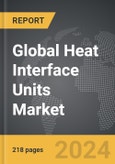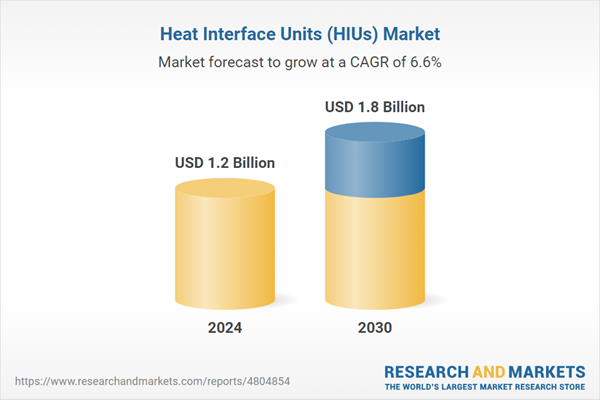Global Heat Interface Units (HIUs) Market - Key Trends and Drivers Summarized
Is the Future of Heating Found in Heat Interface Units (HIUs)?
As the demand for efficient and sustainable heating solutions continues to rise, Heat Interface Units (HIUs) are emerging as a crucial technology in modern energy systems. But what exactly are HIUs, and why are they becoming more prominent? HIUs serve as the intermediary between a central energy source, such as a district heating network, and individual buildings or apartments. These units regulate the distribution of heating and hot water, providing localized control while drawing energy from a centralized supply. This system offers significant efficiency advantages, especially in densely populated urban areas where centralized energy distribution can reduce overall energy consumption.HIUs are particularly relevant in regions with established district heating systems, such as parts of Europe and Scandinavia. They enable individual properties to benefit from the efficiency of a centralized energy system without compromising on control over their heating and hot water usage. In new residential developments, HIUs are often preferred because they eliminate the need for individual boilers, reducing maintenance requirements and installation costs. This shift towards communal energy solutions is also being driven by increased environmental awareness, as centralizing heat production allows for the use of renewable energy sources and efficient large-scale technologies such as combined heat and power (CHP) plants.
How Are Technological Advancements Shaping HIUs?
Technology is playing a pivotal role in the evolution of Heat Interface Units, making them more efficient, user-friendly, and adaptable to various settings. Modern HIUs are equipped with sophisticated control systems that allow for precise regulation of heat and hot water delivery, ensuring optimal performance and energy efficiency. For instance, many HIUs now include modulating controls that can adjust the flow of energy based on real-time demand, preventing wastage and lowering operating costs for end users. This is particularly valuable in buildings with variable occupancy levels, such as hotels or apartment complexes, where energy demand can fluctuate throughout the day.Another key technological advancement is the integration of smart meters and remote monitoring systems. These features allow both users and energy providers to track energy consumption in real time, optimizing usage patterns and identifying inefficiencies. Smart HIUs can also be remotely diagnosed and maintained, reducing the need for physical inspections and enabling quicker response times in case of system failures. Additionally, some HIUs are designed to be compatible with renewable energy sources, such as solar thermal systems or heat pumps, further enhancing their environmental credentials. These innovations are making HIUs not only more efficient but also easier to manage and maintain, contributing to their growing adoption in both residential and commercial settings.
Why Are Consumers and Developers Turning to HIUs?
The shift toward sustainable living and energy efficiency is one of the primary reasons consumers and developers are increasingly adopting Heat Interface Units. In a world where energy consumption and carbon emissions are under constant scrutiny, HIUs offer a more efficient way to manage heating and hot water. For end-users, the appeal lies in the ability to control their own energy usage while benefiting from the efficiency of a district heating system. HIUs allow for individual metering, meaning consumers can pay for the energy they actually use, rather than relying on an average distribution across a multi-unit building, which is a common problem with older, communal heating systems.From a developer's perspective, HIUs offer a lower-cost, lower-maintenance alternative to traditional individual heating systems like gas boilers. Since HIUs are connected to a centralized heat source, they reduce the need for complex gas installations and the associated safety risks. This makes HIUs especially attractive in large residential developments, multi-family housing units, and urban regeneration projects where space and energy efficiency are at a premium. In addition, regulatory pressures to reduce carbon footprints are driving developers to adopt systems that support sustainability goals, and HIUs fit squarely into that framework by promoting efficient energy use on a large scale.
Outdoor applications of HIUs are also growing in popularity, particularly in mixed-use developments where heating systems need to serve both residential and commercial units. By centralizing heat generation and distributing it via HIUs, these developments can meet diverse energy needs while simplifying system maintenance and reducing carbon emissions. These practical benefits, combined with the broader trend towards environmental sustainability, are contributing to the rapid adoption of HIUs in various types of building projects.
What Factors Are Driving the Growth of the HIU Market?
The growth in the Heat Interface Unit (HIU) market is driven by several factors, all linked to evolving technology, consumer preferences, and the global push toward energy efficiency. One of the primary drivers is the increasing adoption of district heating networks, especially in urban areas where high-density living makes centralized energy solutions more viable. District heating systems, coupled with HIUs, provide an efficient way to distribute heat and hot water without the need for individual boilers in every apartment or house, reducing both upfront costs and long-term maintenance requirements.The move towards decarbonization in the energy sector is another key factor. Governments across the world are tightening regulations on carbon emissions, and HIUs offer an efficient solution that helps buildings meet these stringent targets. With the ability to integrate renewable energy sources, such as biomass, geothermal, or solar thermal, HIUs are becoming a go-to choice for developers looking to future-proof their projects against upcoming regulations. Additionally, technological advancements like smart meters and remote monitoring have made HIUs more appealing, providing real-time data that helps users manage their energy consumption more effectively and identify areas for improvement.
Consumer demand for greater control over energy use and cost efficiency is also propelling the market. HIUs allow for individualized energy metering, meaning consumers can directly influence their heating costs by adjusting their usage. This transparency is particularly attractive to consumers in multi-unit buildings, who want to avoid paying for shared heating expenses. The growing trend toward smart home technology, which prioritizes energy efficiency and ease of control, complements the rise of HIUs, as many modern units are designed to be integrated into wider home automation systems. Finally, the increasing focus on sustainability in both residential and commercial building projects means HIUs will continue to play a key role in achieving energy-efficient and low-carbon living spaces for years to come.
Report Scope
The report analyzes the Heat Interface Units (HIUs) market, presented in terms of market value (USD). The analysis covers the key segments and geographic regions outlined below.- Segments: Component (Heat Exchangers Component, Controllers Component, Pumps Component, Sensors Component, Valves Component); Product (Indirect HIUs, Direct HIUs); Application (Residential Application, Commercial Application, Industrial Application).
- Geographic Regions/Countries: World; United States; Canada; Japan; China; Europe (France; Germany; Italy; United Kingdom; Spain; Russia; and Rest of Europe); Asia-Pacific (Australia; India; South Korea; and Rest of Asia-Pacific); Latin America (Argentina; Brazil; Mexico; and Rest of Latin America); Middle East (Iran; Israel; Saudi Arabia; United Arab Emirates; and Rest of Middle East); and Africa.
Key Insights:
- Market Growth: Understand the significant growth trajectory of the Heat Exchangers Component segment, which is expected to reach US$619.1 Million by 2030 with a CAGR of 5.4%. The Controllers Component segment is also set to grow at 6.9% CAGR over the analysis period.
- Regional Analysis: Gain insights into the U.S. market, valued at $245.2 Million in 2024, and China, forecasted to grow at an impressive 7.3% CAGR to reach $166.9 Million by 2030. Discover growth trends in other key regions, including Japan, Canada, Germany, and the Asia-Pacific.
Why You Should Buy This Report:
- Detailed Market Analysis: Access a thorough analysis of the Global Heat Interface Units (HIUs) Market, covering all major geographic regions and market segments.
- Competitive Insights: Get an overview of the competitive landscape, including the market presence of major players across different geographies.
- Future Trends and Drivers: Understand the key trends and drivers shaping the future of the Global Heat Interface Units (HIUs) Market.
- Actionable Insights: Benefit from actionable insights that can help you identify new revenue opportunities and make strategic business decisions.
Key Questions Answered:
- How is the Global Heat Interface Units (HIUs) Market expected to evolve by 2030?
- What are the main drivers and restraints affecting the market?
- Which market segments will grow the most over the forecast period?
- How will market shares for different regions and segments change by 2030?
- Who are the leading players in the market, and what are their prospects?
Report Features:
- Comprehensive Market Data: Independent analysis of annual sales and market forecasts in US$ Million from 2024 to 2030.
- In-Depth Regional Analysis: Detailed insights into key markets, including the U.S., China, Japan, Canada, Europe, Asia-Pacific, Latin America, Middle East, and Africa.
- Company Profiles: Coverage of players such as Alfa Laval AB, Bosch Thermotechnology, Caleffi SpA, COMAP International, Danfoss A/S and more.
- Complimentary Updates: Receive free report updates for one year to keep you informed of the latest market developments.
Some of the 37 companies featured in this Heat Interface Units (HIUs) market report include:
- Alfa Laval AB
- Bosch Thermotechnology
- Caleffi SpA
- COMAP International
- Danfoss A/S
- Docherty Group
- Dutypoint Ltd
- Elco Heating Solutions
- Elson Hot Water
- Emmeti SpA
- Essco Controls Ltd.
- Evinox Energy Ltd.
- Giacomini SpA
- Heatrae Sadia
- Honeywell International, Inc.
- Intatec Limited
- Johnson & Starley Ltd.
- KaMo GmbH
- Kingspan Group PLC
- Kvm-Conheat
- Reliance Worldwide Corporation Limited
- Rhico Ltd.
- S. A. Armstrong Limited
- Stokvis Industrial Boilers (International) Ltd.
- Thermal Integration Ltd.
This edition integrates the latest global trade and economic shifts into comprehensive market analysis. Key updates include:
- Tariff and Trade Impact: Insights into global tariff negotiations across 180+ countries, with analysis of supply chain turbulence, sourcing disruptions, and geographic realignment. Special focus on 2025 as a pivotal year for trade tensions, including updated perspectives on the Trump-era tariffs.
- Adjusted Forecasts and Analytics: Revised global and regional market forecasts through 2030, incorporating tariff effects, economic uncertainty, and structural changes in globalization. Includes historical analysis from 2015 to 2023.
- Strategic Market Dynamics: Evaluation of revised market prospects, regional outlooks, and key economic indicators such as population and urbanization trends.
- Innovation & Technology Trends: Latest developments in product and process innovation, emerging technologies, and key industry drivers shaping the competitive landscape.
- Competitive Intelligence: Updated global market share estimates for 2025, competitive positioning of major players (Strong/Active/Niche/Trivial), and refined focus on leading global brands and core players.
- Expert Insight & Commentary: Strategic analysis from economists, trade experts, and domain specialists to contextualize market shifts and identify emerging opportunities.
Table of Contents
Companies Mentioned (Partial List)
A selection of companies mentioned in this report includes, but is not limited to:
- Alfa Laval AB
- Bosch Thermotechnology
- Caleffi SpA
- COMAP International
- Danfoss A/S
- Docherty Group
- Dutypoint Ltd
- Elco Heating Solutions
- Elson Hot Water
- Emmeti SpA
- Essco Controls Ltd.
- Evinox Energy Ltd.
- Giacomini SpA
- Heatrae Sadia
- Honeywell International, Inc.
- Intatec Limited
- Johnson & Starley Ltd.
- KaMo GmbH
- Kingspan Group PLC
- Kvm-Conheat
- Reliance Worldwide Corporation Limited
- Rhico Ltd.
- S. A. Armstrong Limited
- Stokvis Industrial Boilers (International) Ltd.
- Thermal Integration Ltd.
Table Information
| Report Attribute | Details |
|---|---|
| No. of Pages | 420 |
| Published | October 2025 |
| Forecast Period | 2024 - 2030 |
| Estimated Market Value ( USD | $ 1.2 Billion |
| Forecasted Market Value ( USD | $ 1.8 Billion |
| Compound Annual Growth Rate | 6.6% |
| Regions Covered | Global |









